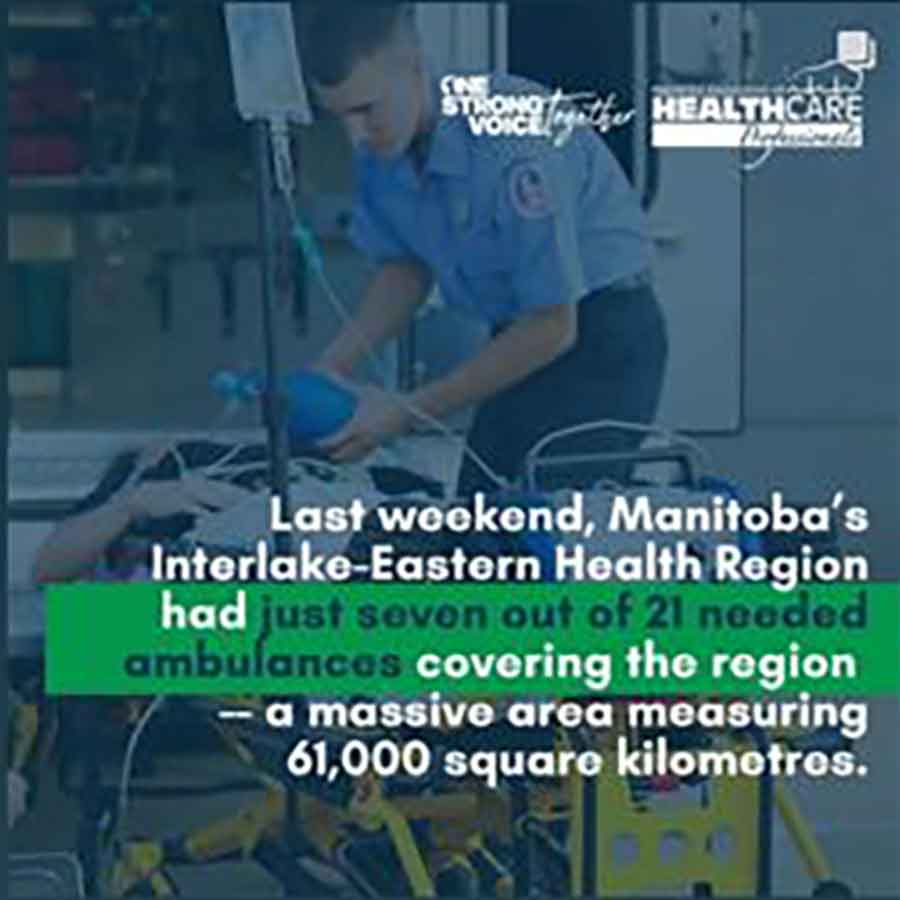MAHCP sees slight improvement in paramedic numbers, but more hiring and retention incentives needed
Although we’ve not been hearing too much lately about paramedic shortages in the Interlake-Eastern Regional Health Authority (IERHA), staffing shortages continue and people are waiting longer for treatment.
A screengrab taken on July 26 from a social media post issued by the Manitoba Association for Health Care Professionals states there were only seven out of 21 ambulances available for the entire health region, which comprises about 61,000 square kilometres and whose hospital ERs are frequently or permanently shuttered because of a lack of staff. The period MAHCP referred to in its post was the weekend of July 20.
Wayne Chacun, who sits on MAHCP’s executive council as treasurer and representative for the Prairie Mountain Health RHA, said the number of ambulances available during that period at one point dropped even further to six. While we haven’t been hearing about paramedic/ambulance shortages in the IERHA for a while, it is “still happening” and what the union saw last month was not a “one-off” situation.
Although there has been a recent improvement in paramedic staffing, it’s negligible in terms of what is required to adequately service rural regions.
“There has been a slight improvement in paramedic staffing since April, but it is very slight,” said Chacun. “I say improved slightly because there are hundreds of vacancies throughout rural Manitoba for paramedics. From April to June, the numbers have increased by 16, according to our calculations, and we’re seeing that consistent loss of paramedics slowing down. But [hiring] is nowhere near what’s needed to fill all these vacancies.”
MAHCP is a union that represents about 7,000 allied health-care workers in 45 professions, including rural paramedics.
MAHCP doesn’t have access to data for that specific period pertaining to what the impact on patients in the IERHA might have been, but Chacun said when there are ambulance shortages there can negative outcomes for patients.
“When we’re short of ambulances, it may take longer for an ambulance to get to patients that need them and there’s a delay in treatment and transport to a hospital,” said Chacun, who is a paramedic in the Prairie Mountain Health region. “It can also result in cancelled transfers between hospitals, where patients need to go from one centre to a centre that offers a higher level of diagnostic services or treatment.”
Compounding paramedic shortages are the number of hospital ERs in the Interlake-Eastern RHA that have either been permanently closed or have to close on a regular basis because of staffing shortages.
For the period Aug 1-15, for example, Ashern’s ER is closed for seven of those 15 days. Eriksdale’s ER is closed for 12 days. Stonewall’s ER is closed for 7 days. Gimli’s ER has five days where 24-7 service cannot be offered. Pinawa’s ER has 11 days of closure with four days on which 24-7 service can’t be offered. Beausejour’s ER is closed for 10 days with five days on which 24-7 service can’t be offered. Pine Falls’ ER shows five days on which it can’t offer 24-7 service. Arborg’s ER continues to remain permanently closed as does Teulon’s. The IERHA posts ER schedules on its website and they are subject to change.
Paramedics are still experiencing burnout and the amount of overtime hours they’re putting in hasn’t improved because of the high number of vacancies in the profession, said Chacun.
“A lot of paramedics hate to see the communities without ambulances so they’ll pick up overtime hours sometimes to the point of exhaustion. When you don’t get time to rejuvenate, it does lead to burnout and pressure on your mental health,” he said. “The same goes for our dispatchers, who are working shifts frequently more than 16 hours until they’re exhausted. And they’re having to stay on the phone longer with people who call for an ambulance to provide support and advice. Our dispatchers are also extremely short-staffed just as our frontline paramedics are.”
Paramedics were without a collective agreement for about five years, he said, and that contributed to their loss in the rural areas where they were earning 26 per cent less than a paramedic working in Winnipeg. Those who stayed behind had to pick up the slack.
“The more short-staffed we are, the more pressure there is on the remaining staff. And some people are finding it tough to deal with this pressure. They’re trying to do work that should be done by another 30 per cent of staff who just aren’t there,” said Chacun. “It’s a rewarding profession, but right now the working conditions are tough.”
There are a number of strategies, however, the provincial government can take to attract and retain rural paramedics, including bringing paramedic training to the rural areas where people want to live and work.
In 2017 the provincial government cut funding for the primary care paramedic program at Red River College, which offered satellite programs in rural areas such as Portage la Prairie, Brandon and the north, said Chacun. Paramedic shortages are worse in some RHA areas such as Prairie Mountain Health and the north because of a lack of training programs in those areas.
“We need to make sure paramedic and other health-care education is available closer to where people live,” he said. “Many times, rural Manitobans are having to move to Winnipeg to get educated, which is difficult to do and entails a financial cost. If we need people to enroll in these courses, let’s offer the courses in the rural areas and provide bursaries to try to get them there. You can’t educate a paramedic in six months; it takes a couple of years or more. The sooner we get people into the program, the better.”
The government could also offer bursaries to attract people to the paramedic program, said Chacun. There are more bursaries currently available for nurses.
The Express reached out to provincial Shared Health – which oversees the delivery of heath-care services and the hiring of paramedics – for comment on the ambulance shortage last month across the IERHA, as well as other issues. The organization offered to answer the questions but requested precise date(s) and times it had occurred (whether it was morning, afternoon or evening) in order to understand what had happened.


